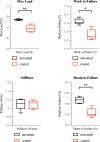Use of affinity allows anti-inflammatory and anti-microbial dual release that matches suture wound resolution
- PMID: 30771234
- PMCID: PMC6527479
- DOI: 10.1002/jbm.a.36658
Use of affinity allows anti-inflammatory and anti-microbial dual release that matches suture wound resolution
Abstract
Surgical sutures are vulnerable to bacterial infections and biofilm formation. At the suture site, pain and undesirable, excess inflammation are additionally detrimental to wound healing. The development of a polymerized cyclodextrin (pCD) coated surgical suture introduces the capability to locally deliver both anti-inflammatory and anti-microbial drugs throughout the phases of acute and chronic healing. Local delivery allows for the improvement of wound healing while reducing related systemic side effects and drug resistance. Through testing, it has been shown that the fabrication of our pCD coating minimally affects the suture's mechanical properties. In vitro studies show measurable and consistent drug delivery for nearly 5 weeks. The therapeutic level of this delivery is sufficient to show inhibition of bacterial growth for 4 weeks, and free-radical scavenging (an in vitro anti-inflammatory activity approximation) for 2 weeks. With this pCD coating technique, we maintain clinical performance standards while also introducing a long-term dual delivery system relevant to the wound healing timeframe. © 2019 Wiley Periodicals, Inc. J Biomed Mater Res Part A, 2019.
Keywords: anti-inflammatory; anti-microbial; drug delivery; suture; wound healing.
© 2019 Wiley Periodicals, Inc.
Conflict of interest statement
Declaration of Interest: HvR is a co-founder of Affinity Therapeutics, but does not receive salary.
Figures






References
-
- Champeau M, Thomassin J-M, Tassaing T, Jérôme C. Current manufacturing processes of drug-eluting sutures. Expert Opin Drug Deliv 2017;14:1293–303. - PubMed
-
- Gys T, Hubens A. A prospective comparative clinical study between monofilament absorbable and non-absorbable sutures for abdominal wall closure. Acta Chir Belg 1989;89:265–70. - PubMed
-
- Leaper D, McBain AJ, Kramer A, Assadian O, Sanchez JLA, Lumio J, Kiernan M. Healthcare associated infection: novel strategies and antimicrobial implants to prevent surgical site infection. The Annals of The Royal College of Surgeons of England. The Royal College of Surgeons of England; 2010;92:453–8. - PMC - PubMed
-
- Gallo AL, Paladini F, Romano A, Verri T, Quattrini A, Sannino A, Pollini M. Efficacy of silver coated surgical sutures on bacterial contamination, cellular response and wound healing. Materials Science and Engineering: C 2016;69:884–93. - PubMed
Publication types
MeSH terms
Substances
Grants and funding
LinkOut - more resources
Full Text Sources

